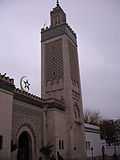Grand Mosque of Paris
| Grande Mosquée de Paris | |
|---|---|
|
The Paris Mosque, with its minaret on the left | |
| Basic information | |
| Location | Paris, France |
| Geographic coordinates | 48°50′31″N 2°21′18″E / 48.84194°N 2.35500°E |
| Affiliation | Islam |
| Website | www.mosqueedeparis.net |
| Architectural description | |
| Architectural type | Mosque |
| Architectural style | Mudéjar style |
| Specifications | |
| Minaret(s) | 1 |
| Minaret height | 33 m |
The Grande Mosquée de Paris (commonly known as The Paris Mosque or The Great Mosque of Paris in English), is located in the 5th arrondissement and is one of the largest mosques in France.
History
The mosque was founded in 1926 as a token of gratitude, after World War I, to the Muslim tirailleurs from France's colonial empire, of whom some 100,000 died fighting against Germany. The mosque was built following the mudéjar style, and its minaret is 33 meters high. It was inaugurated by President Gaston Doumergue on 15 July 1926. Ahmad al-Alawi (1869–1934) led the first communal prayer to inaugurate the newly built mosque in the presence of the French president. He was an Algerian Sufi, founder of the modern Sufi order Darqawiyya Alawiyya, a branch of the Shadhiliyya whose original founder is a Moroccan Sufi.
During World War II (when France and Paris were occupied by Nazi Germany), the rector Si Kaddour Benghabrit managed the mosque to serve as a secret refuge for Algerian and European Jews. He ensured they were provided shelter, safe passage, and fake Muslim birth certificates to protect them from German persecution.[1]
Initially sponsored by the king of Morocco, the mosque was assigned to Algeria in 1957 by the French Foreign Minister. The mosque is currently led by mufti Dalil Boubakeur.
Gallery
References
- ↑ Robert Satloff (October 8, 2006). "The Holocaust's Arab Heroes". The Washington Post. Retrieved 2010-04-28.
External links
| Wikimedia Commons has media related to Mosquée de Paris. |
| ||||||||||||||||















